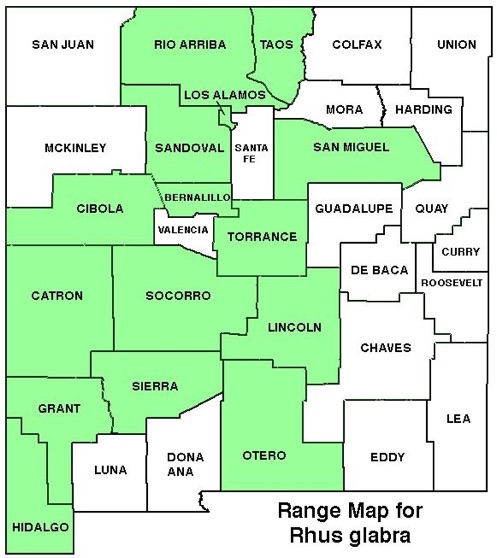WILDFLOWERS OF NEW MEXICO

Reaching 3–10 feet tall (1–3 m) usually with a single trunk and upper branching, this vigorously thicket-forming plant has pinnately compound leaves with large leaflets that turn red in the fall. Note the dense pyramidal clusters of small, creamy flowers followed by small, round red fruit; sap is milky, yellowish.
FLOWERS: June–August. Dense, erect pyramidal clusters 4–10 inches long (10–25 cm) form on branch tips; flowers 1/8 inch long (3 mm) with 5 creamy to greenish-white petals; male and female flowers on separate plants (dioecious). Fruit in dense, erect clusters, drupes fleshy, 1/4 inch diameter (6 mm), bright red, densely glandular-hairy; clusters persist into winter.
LEAVES: Alternate, pinnately compound, stalkless (sessile). Blades have 13–19 lance-shaped leaflets 1 1/2–4 inches long (4–10 cm) by 3/8–1 inch wide (10-25 mm); the main stalk of the leaf (rachis) does not have wings between the leaflets; edges vary from nearly entire to coarsely toothed; surfaces hairless, green above, whitish below; base rounded, tips tapered; turns bright hues of red in autumn.
HABITAT: Sandy, rocky soils, slopes, canyons, floodplains, open areas, roadsides; sagebrush, pinyon-juniper, ponderosa pine-oak forests.
ELEVATION: 5,400–8,700 feet (1642–2651 m).
RANGE: AZ, CA, CO, ID, MT, NM, NV, TX, UT, OR, WA, WY; Great Plains and all states eastward; Canada.
SIMILAR SPECIES: Prairie Sumac, R. lanceolata, infrequent in Dona, Ana, Eddy, Other cos., has wings on the rachis between the leaflets.
NM COUNTIES: Widespread, common in western half of NM in mid-elevation habitats: Bernalillo, Cibola, Catron, Grant, Hidalgo, Lincoln, Los Alamos, Otero, Rio Arriba, San Miguel, Sandoval, Sierra, Socorro, Taos, Torrance.









SMOOTH SUMAC
RHUS GLABRA
Sumac Family, Anacardiaceae
Deciduous shrub to small tree


















THE CONTENTS OF THIS WEBSITE ARE COPYRIGHTED AND CANNOT BE USED
WITHOUT PERMISSION OF GEORGE OXFORD MILLER
















EMAIL ME


















The central rib of the leaf (rachis) does not have wings between the leaflets.

Usually with a single trunk, Smooth Sumac spreads by roots and can form dense colonies
Leaflets turn brilliant red in the fall, and the erect clusters of seeds persist into the winter.

























